

“All we want is honest record-keeping, that’s what we are trying to get. That’s it. It sounds like a pretty simple thing to say but we weren’t getting it out of a lot of significant companies. I mean they were really playing absolutely outrageous games, and they put out these financial statements which had no connection with reality.“(1)
~Sen. Paul S. Sarbanes
“We often think of money as the currency of a free market system, but in truth the system rises and falls on the confidence of its investors.”(2)
~Rep. Michael G. Oxley
The passage of the Sarbanes-Oxley Act (SOX) was the culmination of a race to restore investor confidence. The drive was instigated by the sudden announcement by Enron, the country’s seventh largest company, that it was restating $1 billion in earnings because of accounting issues and its subsequent bankruptcy six weeks later. In the wake of Enron, it became increasingly clear that financial statements purporting to show public company financial results could be severely – sometimes fraudulently - flawed despite the certification of those statements by supposedly independent auditors.

A number of pre-existing factors contributed to the developing support for the legislation, including the realization that the Enron bankruptcy was not an isolated event. There had been an increasing spate of significant earnings restatements and accounting failures from 1997 through 2001, involving companies audited by all the then-Big Five public accounting firms including Waste Management, Cendant, Sunbeam, Rite Aid, MicroStrategy and Lucent Technologies. A 2002 GAO study found that between January 1997 and June 2002, the number of restatements due to accounting irregularities grew an average of 145 percent annually, with about 10 percent of all listed public companies announcing at least one restatement. (3)
Another critical issue was the fact that Enron’s auditor, Arthur Anderson, earned more from the energy company in non-audit fees, including consulting, than from audit fees. To combat this type of conflict of interest, SEC Chairman Arthur Levitt Jr. had engaged in a bruising battle with the audit profession in 2000, yet Congress rebuffed Levitt’s efforts to tighten SEC rules on auditor independence and limitations on providing consulting services to audit clients. Adding to the growing doubts about the veracity of financial information was the June 2001 announcement of an investigation by New York Attorney General Eliot Spitzer into the accuracy of recommendations by securities analysts.
Politics was the final factor that paved the way for the reform legislation. Seven months before the Enron bankruptcy, Sen. Jim Jeffords (R-Vt.) - disappointed in the Bush tax cuts and sparse special education funding – changed his affiliation to Independent and caucused with the Democrats.(4) The move gave the Democrats a razor-thin majority in the Senate and made Sen. Paul S. Sarbanes (D-Md) Chairman of the Senate Banking Committee, which would have primary jurisdiction over issues raised by the Enron collapse and public company audit quality. Sen. Phil Gramm (R-Texas), a fiscal conservative who championed deregulation and whose wife Wendy served on the Enron Board of Directors, lost the chairmanship and the ability to set the Banking Committee’s agenda at a crucial moment.
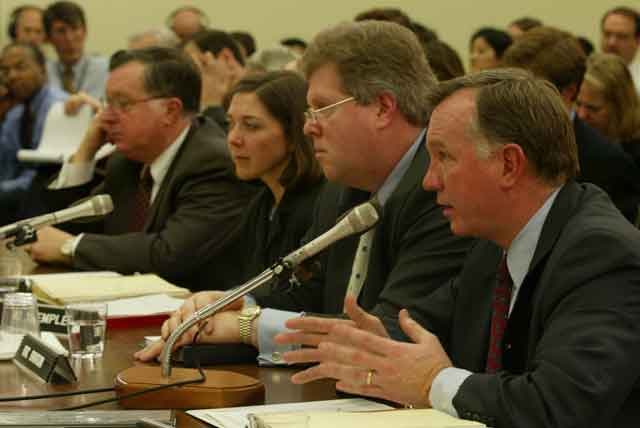
Against this backdrop, the bill was drafted, debated and enacted in less than six months. But it was not hastily concocted as some critics maintain. The Act reflected conclusions about audit quality and financial reporting laid out over 30 years by multiple congressional committees as well as numerous expert panels and commissions sponsored by the SEC or the audit profession.
Wall Street and Main Street were shaken to the core by the sudden bankruptcy of Enron in December 2001. The country’s 85 million investors watched billions of dollars in lifetime savings evaporate as the energy services company disintegrated.
“Almost every time I would go down to the floor during a series of votes, I would have members seek me out and tell me a horror story about an investor back in their district,” said Rep. Michael Oxley (R-Ohio), Chairman of the House Committee on Financial Services. “All over the country you had this total lack of investor confidence. Just outrage about what was happening to them.” (5)
Newly appointed SEC Chairman Harvey Pitt acted quickly to outline the Commission’s approach to dealing with fears about unreliable financial reporting. In a news conference on Jan. 17, 2002, Pitt largely embraced accounting profession positions on key topics like independence, proposed a new private oversight body to oversee ethics and competence, but left most authority for overseeing auditors of public companies within the SEC.
Pitt’s proposal was made without consulting the auditing profession’s existing, private oversight body, the Public Oversight Board (POB). Established in 1977, the five-member board oversaw auditing firms’ ethics and disciplinary activities and administered the peer review program under which firms reviewed each other’s work. Because it was largely funded by the profession, had no legal authority, and relied on voluntary cooperation from the firms, questions arose as to whether the POB had the freedom and independence to fully discharge its responsibilities.
Understanding that Pitt’s proposal would render them obsolete, all five POB members, led by former U.S. Comptroller General Charles A. Bowsher, resigned on Jan. 23, 2002. Bowsher felt Pitt’s proposals “were a sham intended to give the industry more power to discipline itself rather than submit to outside scrutiny.” (6)
Less than two weeks later, leaders from the accounting firm Arthur Andersen asked former Federal Reserve Board Chairman Paul A. Volcker and others including Bowsher, to help overhaul the firm in the wake of its involvement with the Enron collapse. Volcker put forth an ambitious plan to restructure the partnership, but the effort became moot on March 14, 2002, when the Department of Justice indicted Andersen on obstruction of justice charges for shredding documents related to its Enron audit. After a six-week trial in Houston, a jury found Andersen guilty, and the venerable 89-year-old firm, that had once represented the gold standard for auditing integrity and technical precision, had to surrender its licenses to practice public accounting in the U.S. Within months, the firm that had boasted 85,000 worldwide employees and $9.3 billion in 2001 revenue was closing its doors. As a result, and to the detriment of competition, the Big Five accounting firms were consolidated to the Big Four. Three years later, the Supreme Court unanimously reversed the guilty verdict, but it was too late for Andersen.
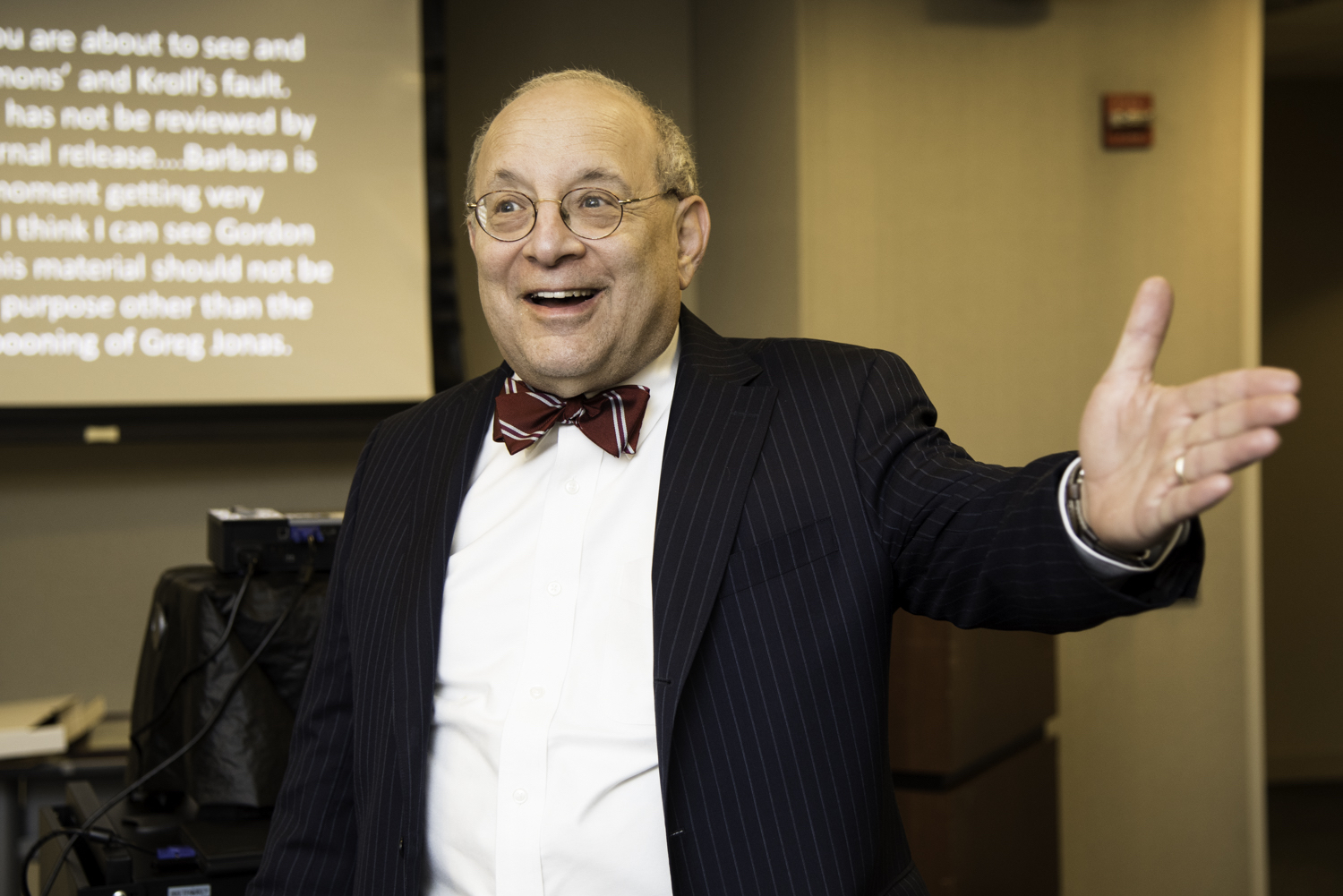
As midterm elections loomed, nineteen Congressional committees and subcommittees held hearings on Enron and financial reporting reform. (7) Both houses of Congress began developing legislation to protect investors from fraudulent financial reporting.
“Amid the blizzard of hearings and headlines, there was an appetite to solve problems,” said Stephen R. Kroll, Special Counsel to the Senate Banking Committee.
In the Republican-controlled House, Rep. Oxley introduced the Corporate and Auditing Accountability Responsibility, and Transparency Act (CAARTA, H.R. 3763). The bill called for a regulatory organization created by the SEC to assess conflicts of interest, review auditors’ compliance with professional standards and audit quality, and discipline auditors in certain situations.
The Senate Banking Committee chose to build a basis for action by creating a comprehensive hearing record similar to the Moss and Metcalf congressional investigations (1976-1979) and Dingell-Wyden House hearings (1980-1985) that had explored problems in financial reporting and the auditing profession.
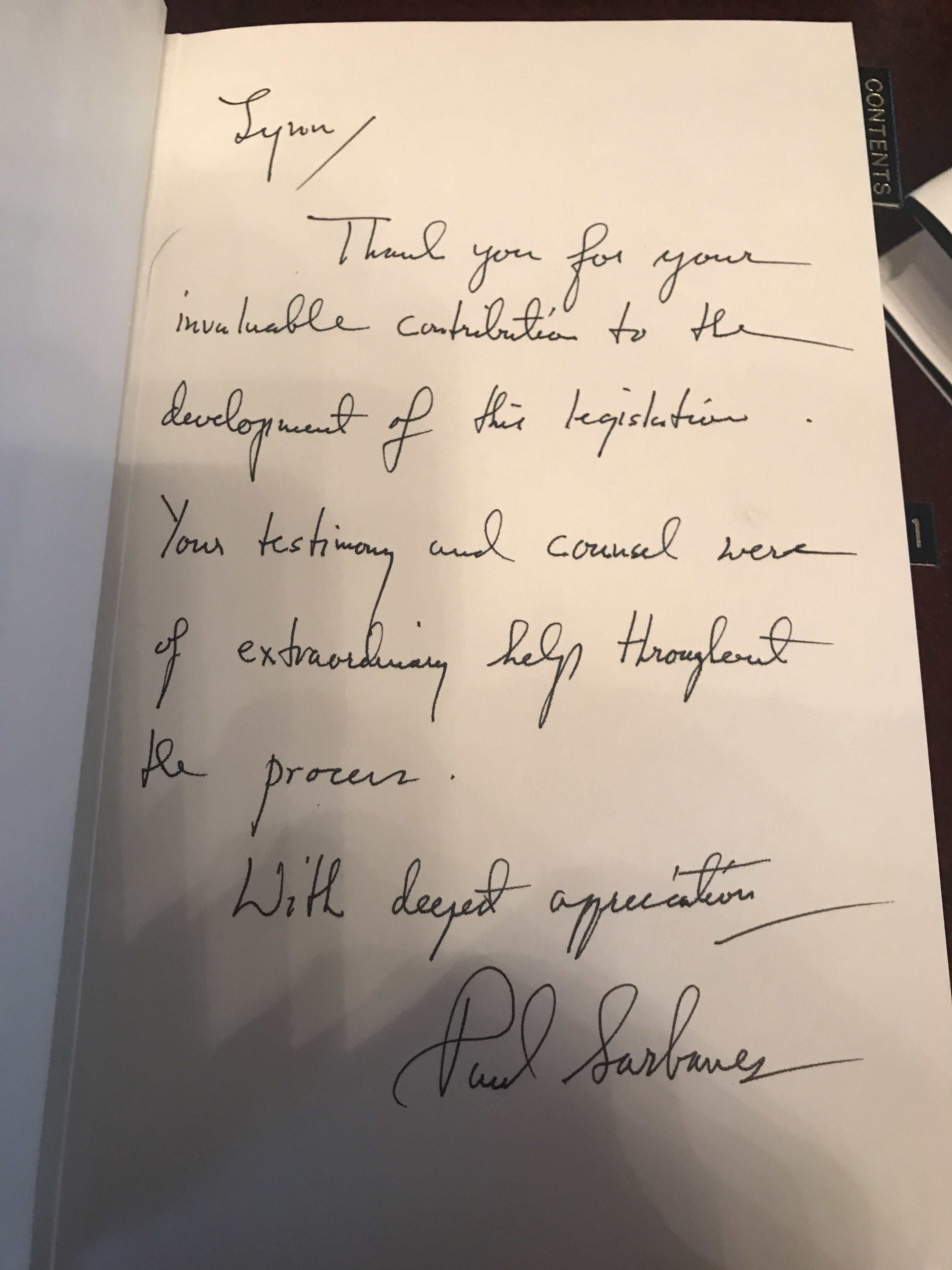
The Committee’s Democratic staff organized ten hearings, presenting 39 witnesses over six weeks. According to the final witness, SEC Chairman Harvey Pitt, the hearings represented “a landmark example for future Congresses.”
The Banking staff also began drafting a new bill, consulting with an informal group of advisers – many of whom reached out and offered a smorgasbord of proposals. The group included Charles Bowsher and such former SEC luminaries as Directors of Enforcement Irving Pollack and Judge Stanley Sporkin; Chief Accountants Lynn E. Turner, Walter P. Schuetze, and Michael H. Sutton; Director of the Division Corporation Finance and former Chief Counsel of the Public Oversight Board Alan B. Levenson; and former SEC Chairman Arthur Levitt. Also offering advise were Paul A. Volcker; Gary Gensler, former Goldman Sachs partner and Treasury Department Under Secretary for Domestic Finance; Joel Seligman, securities law scholar; accounting professors Lee J. Seidler and Abraham J. Brilloff; and Sir David Tweedie, Chair of the International Accounting Standards Board. According to top aides, Lynn Turner was an especially active, creative source of ideas and support and Gary Gensler, future Chairman of the Commodity Futures Trading Commission and Chairman of the SEC, provided a unique perspective.
“These were wise people, with deep expertise, whom we utilized as a sounding board but kept off the radar screen,” said Martin J. Gruenberg, former Banking Committee Senior Counsel and later Chairman of the Federal Deposit Insurance Corporation.
While the Senate hearings progressed, President Bush announced March 7, 2002, his 10-point plan to “improve corporate responsibility and protect America’s shareholders.”(8) The plan established a private board to oversee the competence and ethics of auditors and echoed rule changes already suggested by the SEC. Democrats criticized the President’s proposal for not offering a sufficient platform for change necessary to enhance auditor independence and assure audit quality.(9)
Meanwhile, the steady drumbeat of corporate fraud continued. In early April, Xerox, Adelphia, and Tyco International announced restatements involving accounting irregularities or net losses totaling hundreds of millions of dollars.
In the House, Rep. Oxley’s committee reported the CAARTA bill to the House floor after three days of hearings. Two days later, on April 24, 2002, the bill passed the House by a vote of 334-90. While the bill had the support of the White House, SEC Chair Harvey Pitt, and the accounting profession, it was viewed as toothless by Democrats, as well as accounting reform and investor advocates. (10)
“We had established a beach head, taken ownership of the issue,” said Terry Haines, former Chief Counsel and Staff Director for the House Financial Services Committee, “but Sarbanes had a devil of a time corralling his senators and nothing happened.”
The Senate Banking Committee was moving so slowly in crafting its bill that some in the Democratic leadership worried it was losing legislative momentum. According to staffers, Sarbanes was moving deliberately “because he needed members on both sides of the aisle to be sold on the bill in the face of virtually total opposition by the accounting profession and uncertainty, at best, on the part of the public company universe.” When Sarbanes’ staff finally assembled their measure, they had to cancel the initial markup scheduled for May 21, 2002, because they lacked the votes to approve it.
“Then we began to engage each member one by one,” said Gruenberg. They started by winning the support of their Democratic members first, but understood they would need Republican votes as well.
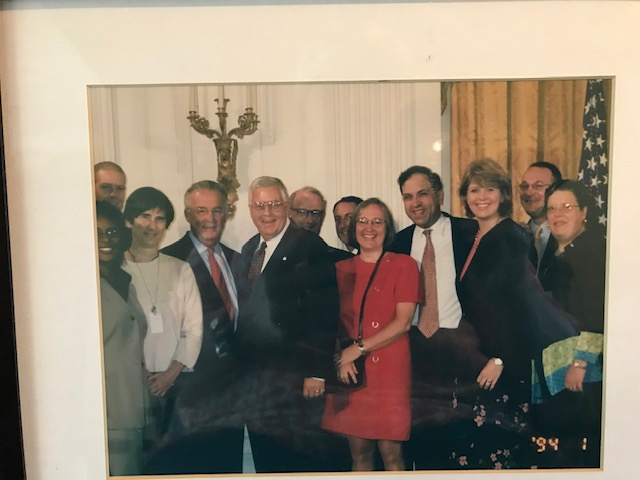
In the midst of the Senate negotiations, Wall Street appeared to signal fledgling, but critical, support for reform. Henry M. Paulson Jr., Chairman and CEO of Goldman Sachs, spoke at the National Press Club on June 5, 2002. “Our financial markets are the deepest, most efficient, and fairest to be found anywhere,” he said. “But they are not perfect. And it’s time that we fix them.”(11)
The turning point for the Senate bill came when Sarbanes secured the support of Sen. Mike Enzi (R-Wyo) the only accountant in the Senate. Enzi had become the accounting lobbyists’ sounding board, shuttling between the Senate and the accounting firms, swapping proposals and bearing the bad news when the profession’s positions were rejected.(12)
According to several top aides, the deal came together the evening of June 17, 2003, the night before the bill’s markup. Sen. Enzi and his subcommittee Staff Director Katherine B. McGuire met with Sarbanes and senior staff at 10 p.m. Even though Sarbanes appeared to have all 11 Democratic votes on his committee, he needed bipartisan support both in his committee and on the Senate floor. Enzi laid out his requests, which Sarbanes thought were reasonable. McGuire and the Sarbanes staffers then worked throughout the night to iron out the details, fortified by reception leftovers delivered after midnight by Enzi and his wife Diana.
Enzi won concessions that allowed partial confidentiality of Board inspection reports, and a provision that allowed for disciplinary proceedings against accounting firms to be kept confidential until all appeals to the SEC are exhausted. The provision still riles the PCAOB today as it incentivizes firms to litigate and postpone, often for years, the release of information that the Board has charged a firm or auditor with a violation.
The following day, just before the markup, SEC Chairman Harvey Pitt met with Banking Committee Republicans in Sen. Gramm’s office to seek their support to oppose the bill. But by then, Enzi and several other Republicans were backing Sarbanes, and the bill was approved by the Senate Banking Committee, by a vote of 17-4.
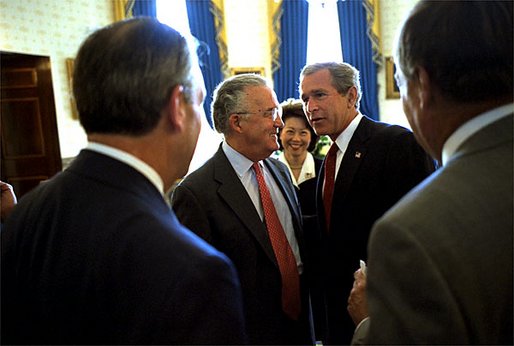
Despite the bill’s overwhelming committee approval, the Senate leadership could not provide floor time for the Sarbanes bill until September, after the election-year summer recess. The bill’s supporters worried that the stock market might recover by then, allowing public anger to fade and dimming prospects for passage, or that other matters would push the bill aside.
Just as it appeared that the Sarbanes bill could be sidetracked, another audacious financial accounting fraud surfaced, dwarfing the Enron bankruptcy and reigniting public outrage. On June 25, 2002, WorldCom, the country’s second largest long-distance carrier, announced it had overstated its 2001 earnings by more than $3.8 billion. (The restatement would ultimately grow to $10 billion). A day later, the company announced that 17,000 of its 80,000 employees would likely lose their jobs.(13) Congressional staffers immediately understood the importance of this news.
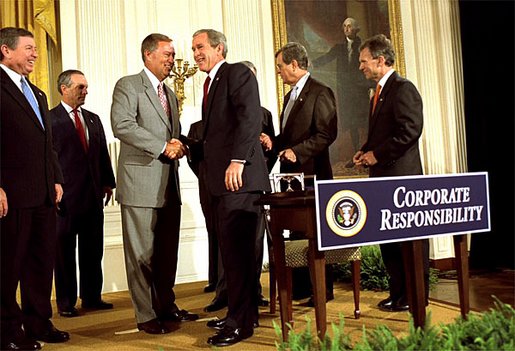
“The battle is over,” thought Senate Banking Committee Special Counsel Stephen Kroll, as he glimpsed the headline in the Washington Post on his front steps.
“We’ve lost our leverage,” realized Terry Haines, who was driving to Rep. Oxley’s Virginia home when he heard the WorldCom story on the radio.
The Sarbanes bill rocketed to the top of the Senate calendar as Majority Leader Thomas A. Daschle (D-S.D.) asked for a committee report within days. Staff worked over the July Fourth weekend to complete it in time. Debated on the Senate floor from July 8 – 15, the bill attracted 122 amendments. Only thirteen were adopted,(14) all of which strengthened the bill, including provisions adding new penalties for financial fraud and easing the ability to prosecute corporate abuses. The bill passed 97-0 and headed for a House-Senate conference.
During his weekly radio address July 20, President George W. Bush called for Congress to have a corporate reform bill on his desk before the August recess. The Dow Jones industrial average had just sunk to its lowest point in more than four years, losing nearly 24 percent since April 24, 2002, when the House passed its bill.(15) The NASDAQ was down more than 28 percent from the same day, its nadir for the past six years.(16) State employee pension funds had lost over $3 billion from WorldCom and Enron alone.(17)
Haines and Rep. Oxley then met with Sen. Sarbanes to negotiate. “To his credit, Sarbanes was reasonable,” said Haines. “He could have stuck it to us.” Oxley won some important concessions including the creation of a Fair Fund that would use SEC civil fines and disgorgement payments to compensate defrauded investors. However, the conference bill was “more of an acquisition than a merger, primarily adopting the Sarbanes language,” said Democratic staffer Alex Sternhell of the Senate Banking Committee.
As the conference wrapped up, a top Senate aide told Haines that Sarbanes would not put his name on the legislation unless Oxley’s appeared as well. Oxley quickly agreed and went on to become a strong advocate of the Act despite having taken a different approach in his own bill. Sarbanes and Oxley appeared together frequently to publicize and defend the Act, even taking their SOX roadshow to India and Japan.
Senate aides say after Oxley agreed to lend his name to the bill, Sarbanes then called Sen. Enzi to report the Act’s title. According to staffer Katherine McGuire, Sen. Enzi was unfazed and perhaps a little delighted not to be in the limelight.
“He is a workhorse, not a show horse,” said McGuire, a metaphor often used to describe Sen. Sarbanes as well. She believes Sen. Enzi solidly shares in the credit and legacy for structuring what President Bush called “the most important corporate reform of our time.” According to his staff, Sarbanes also shared that belief.
The Sarbanes-Oxley Act was officially signed into law on July 30, 2002, paving the way for a new era of financial oversight and corporate responsibility. The road from public outrage at Enron’s accounting fraud to signed legislation relied not only on skilled political maneuvering and bipartisanship, but also on a rare and unforeseen alignment of events.
(1) SEC Historical Society Program, “The Sarbanes-Oxley Act: The First Decade, July 30, 2012,” George Washington University, July 30, 2012.
(2) Current Issues in Auditing, Vol. 1, “The Sarbanes-Oxley Act of 2002 – Restoring Investor Confidence,” by Michael G. Oxley, 2007.
(3) General Accounting Office, “Financial Settlement Restatements: Trends, Market Impacts, Regulatory Responses, and Remaining Challenges,” GAO-03-138, October 2002.
(4) Washington Post, “How Jim Jeffords Single-Handedly Bent the Arc of Politics,” by Paul Kane, Aug. 18. 2014.
(5) SEC Historical Society Oral History with Rep. Michael Oxley by James Stocker, March 9, 2012.
(6) New York Times, “Enron’s Collapse: Accounting; Accounting Board Resigns Over New Plan,” by Stephen Labaton, Jan. 23, 2002.
(7) Law Library of Congress, Guide to Law Online: “Enron Hearings”
(8) Office of the White House Press Secretary, “President Outlines Plan to Improve Corporate Responsibility,” March 7, 2002.
(9) CQ Weekly, “Democrats Say Bush’s Investor Protections Do Not Go Far Enough,” by Keith Perine, March 9, 2002.
(10) New York Times, “GOP Bill on Auditing Clears House,” by R. Oppel Jr., April 25, 2002.
(11) “Restoring Investor Confidence: An Agenda for Change,” by Henry M. Paulson Jr., June 5, 2002, page 2.
(12) Washington Post, “How Congress Rode a ‘Storm’ to Corporate Reform,” by David S. Hilzenrath, Jonathan Weisman, Jim VandeHei, July 28, 2002.
(13) Washington Post, “Telecom Firm Left Its Employees Frustrated, Jobless,” by Amy Joyce and Yuki Noguchi, March 3, 2004.
(14) Congress.gov, Amendments: S 2673 – 107th Congress (2001-2002) – Public Company Accounting Reform and Investor Protection Act of 2002
(15) Primary Events on the Road to Passage and Implementation of the Sarbanes-Oxley Act,” prepared for Senator Paul S. Sarbanes, by Stephen R. Kroll, p.33
(16) Ibid.
(17) Ibid, page 28.
Charles Bowsher served as the 6th Controller General of the U.S. from 1981-1996. During that period, he led the Government Accountability Office in addressing the savings and loan crisis. He was instrumental in Congress’ passage of the Single Audit Act of 1984 requiring audits for state and local governments, and the Chief Financial Officers Act of 1990, requiring federal departments and agencies to prepare financial statements and undergo annual financial audits. Mr. Bowsher is a graduate of the University of Illinois at Urbana-Champaign, and earned an MBA from the University of Chicago.
Lynn E. Turner, B.A. M.A. C.P.A., served as Chief Accountant of the Securities and Exchange Commission from July 1998 to August 2001. Mr. Turner was actively involved in the legislative process leading up to passage of the Sarbanes-Oxley Act. In 2007, U.S. Department of Treasury Secretary Henry Paulson appointed Mr. Turner to the Treasury Committee on the Auditing Profession. Prior to the SEC, Mr. Turner spent 20 years with Coopers & Lybrand (now PwC). He previously held positions as vice president and chief financial officer of an international semiconductor company as well as Professor of Accounting at Colorado State University. Mr. Turner has served on boards of public companies and also has served as trustee of a mutual fund and $40 billion pension fund.